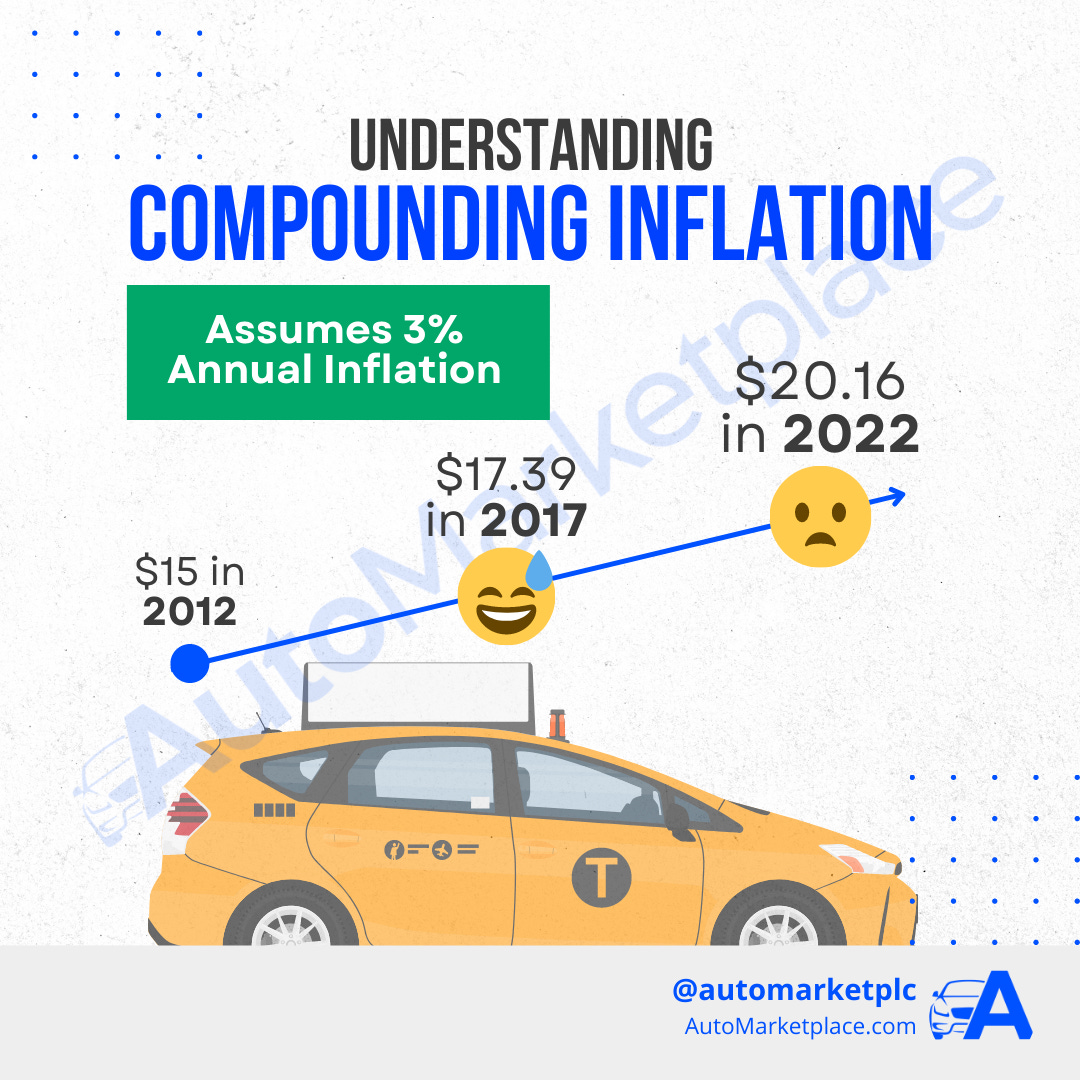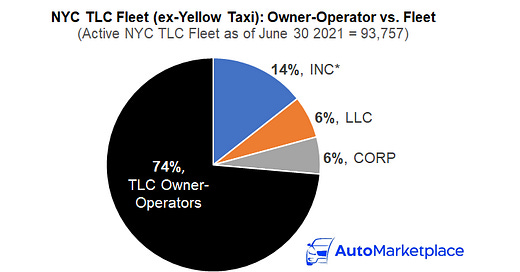

Discover more from AutoMarketplace
OPINION: NYC Yellow Cab Fares Will Likely Increase More Than 25%. Lease Caps Will Be Important Discussion Point Leading to Medallions Breaking $200,000+ Valuation
NYC yellow taxi industry is looking to increase fare rates, the first time in 10 years, to reflect higher costs of doing business. Two TLC hearings will focus on overall industry economics & dynamics




AutoMarketplace.com NYC covers the for-hire transportation industry and automotive news. Check out AutoMarketplace.com on YouTube ▶️
⏱️TL;DR Summary
📅 NYC TLC will hold two consecutive meetings in late May, ahead of major decisions on pricing, leasing and other industry initiatives
🚕 Yellow taxi fares will likely have a headline increase of over 25%, which in reality represents a 3% per year inflation “catch up”
🗳️ 2012 taxi politics has a lot to teach us about how 2022 might look
🪙 Taxi lease caps will likely be raised, positively impacting medallion valuations. FHV Corporations (aka TLC leasing companies) are also likely to be subjected to similar lease caps
🌱 A new TLC industry status quo is beginning to take shape
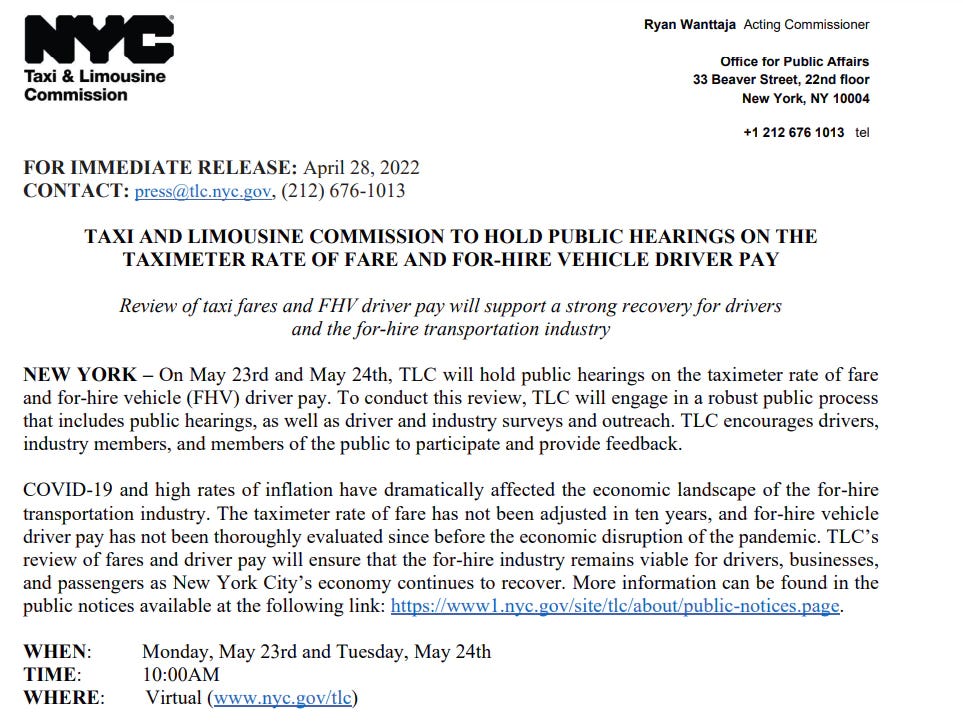
NYC Taxi & Limousine Commission (TLC) hearings scheduled for Monday, May 23rd and Tuesday, May 24th (both at 10 a.m.) ⏰ will focus on NYC TLC driver pay and general industry economics. Looking at history, several other dynamics will likely be discussed. For example, yellow taxi garage lease cap rules were a major part of the 2012 debate🤔.
The upcoming TLC meetings might be among the most consequential in recent memory and we encourage all TLC drivers and industry participants to sign up ✍🏾.
📅 Sign-Up✍🏻 & Agenda - Monday, May 23rd: https://www1.nyc.gov/assets/tlc/downloads/pdf/proposed_rules_taximeter_rate_of_fare_05_23_22.pdf
📅 Sign-Up✍🏿 & Agenda - Tuesday, May 24th: https://www1.nyc.gov/assets/tlc/downloads/pdf/proposed_rules_hire_vehicle_driver_pay_05_24_22.pdf
The last time yellow cab fare rates were adjusted was in 2012. At that time, just before the rise of Uber and Lyft, taxi meter rates went up by 17% 📈. The headline 17% figure is misleading and to the public might seem really high. However, if taxi meter fares hadn't been adjusted for the previous seven years, the real increase is much more modest, ~2.3% per year. Many people often have a hard time understanding compounding inflation📈📈📈. In other words, if a $15 trip tracks inflation of 3% per year, after 10 years the same trip would have increased by $5.16 or 34%📈!
2012 Fare Hike History & How It Informs 2022
We found an interesting New York Taxi Workers Alliance (NYTWA) video montage from 2012 that gives "at the moment" insight into the 2012 fare hike. One interesting thing to note is how much drivers were making at the time. A yellow taxi driver, Qaiser Hashmi, is quoted as saying he was making $110 (take home, post expenses pre-rate increase) per 12 hour shift and that would increase to ~$150 if the fare hike was approved. If you assume a 10 year, 3% average NYC local inflation per year 💸 over the past decade, $150 in 2012 would be about $202 in today's (2022) money.
😡But AutoMarketplace, inflation is much higher than 3%!😡
We know, we know. General inflation is likely underestimated, but we’re actually OVERESTIMATING 👀 vs. official government guidance. In reality, we believe actual inflation, specifically related to living and working in the New York City for-hire transport market, has likely outpaced 3% per annum since 2012. In fact, one purpose of the TLC meetings will likely discuss what actual NYC TLC industry-specific inflation has been.
This isn’t the point of this article, but as we mentioned before in the context of increasing TLC insurance expenses, this is why we believe (note: not investment advice) Bitcoin ₿ might be an interesting asset for many TLC drivers to consider.
That discussion though, is for another time!
Taxi Lease Caps vs. Driver Pay
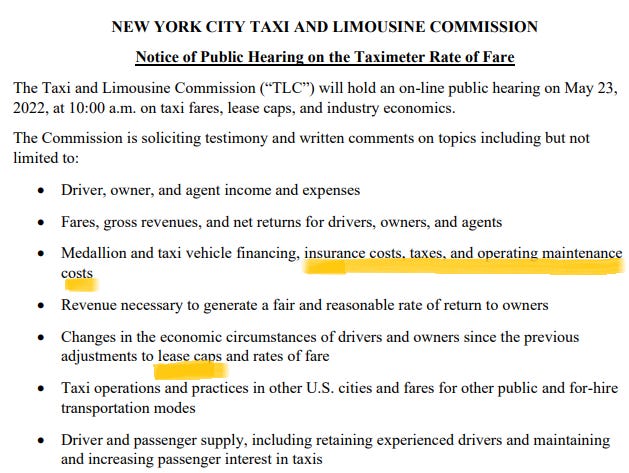
Towards the end of the NYTWA 2012 news montage above, there is some interesting commentary regarding taxi garages and lease caps. For many NYC TLC drivers, who've never leased from yellow taxi garages, the topic is probably unfamiliar. In fact, you might be wondering how it relates to a discussion about fare increases?🤔
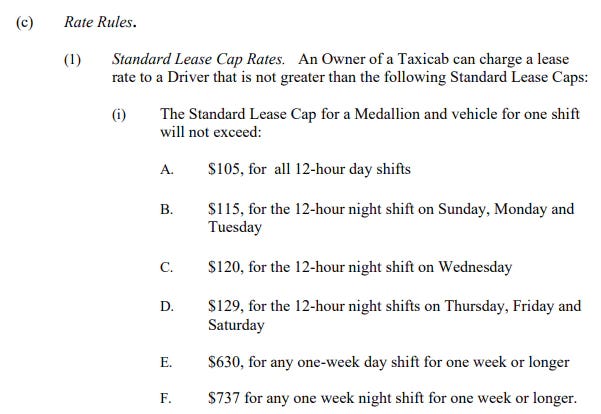
Basically, given an NYC taxi medallion gives a monopoly right to street hails and accrues value, at least partially, based on that right, rules were made to make sure that taxi medallion owners / garages didn't abuse their power. Makes sense 👍. In the last segment of the montage, note the argument made by then TLC Chair David Yassky.
"You know there are only 13,000 taxis that may sound like a lot but in a city this big they'd be demand for a lot more, so those taxi medallions are quite valuable and we try to make sure that those fleet owners who own those medallions can't exploit the drivers by taking all the money that comes in." - Former TLC Chair David Yassky (Begins at 10:13 of NYTWA Montage above)
Mr. Yassky is basically arguing that although taxi garages probably wanted their lease cap rates to increase if drivers got a pay raise, that they shouldn't really be complaining given how much medallion values were up. In addition, increasing lease cap rates may negate a lot of the increased pay benefits for drivers that leased cabs from garages. This was obviously all just before Uber, so hindsight is 20/20, and we all know what happened to medallion values.
Taxi Lease Caps & Medallion Valuations
So, if another driver pay increase gets approved (we believe it should) without any increase in taxi lease cap rates, taxi garages that own and lease medallions, might find that upsetting 😒. Their arguments, somewhat justified, is that their own costs from maintenance to insurance are also increasing. If drivers get a pay increase, it's only fair that lease caps (which seemed to be untouched in 2012) should be re-rated higher.
Given medallion values have plummeted, it also strengthens their argument. Think about it like this. You want to increase the value of the NYC yellow cab medallion? Does increasing taxi lease cap rates, increase or decrease the value another party would pay for an NYC taxi medallion? 🚕🚖 The answer is, we believe, increasing lease caps will significantly re-rate medallion values upwards. Drivers that own their own medallions, might actually BE IN SUPPORT 🤝 of lease caps being raised because it would effectively increase the value of their own assets, while not negatively impacting them (they don’t rent).
The next five to ten years might go down in history as the "revenge of the medallion" 📈📈📈. Everything is now in place (from a debt restructuring to the FHV License Pause) for NYC taxi medallions valuations to rise. We predict, medallion valuations will be in excess of $200,000 next year and probably well over $300,000 over the next 2 to 3 years. Everything is interconnected, NYC TLC drivers and other participants should connect the dots.
Creating “Uber Lease Caps”
Another point, we’ll briefly mention (we’ve written about this before) is the likely creation of FHV Corporation Lease Cap Rules. As we've written several times, the FHV License Pause (TLC Plate Cap) is unlikely to change for several years. Therefore, “FHV Corporations”, especially large leasing companies that have access to thousands of FHV licenses, will likely be subject to the same sort of lease caps that taxi garages must comply with. A major difference though is that most FHV Corps (aka TLC leasing companies), do not rent their cars by shift, but rather 24/7 to one driver who takes the car home. In addition, most drivers who lease their TLC cars are subjected to 25%+ commissions by Uber and Lyft, something yellow cab drivers are not (at least not currently).
Finally, I expect the "traditional" black car and livery industry to make their case for an exemption to the TLC Plate Cap, to help them grow and maintain their businesses.
Conclusion
Given the increasing costs of doing business with historic inflation, especially gas prices, a fare hike is likely overdue for the yellow cab industry. Higher taxi fares will likely decrease cost competitiveness vs Uber & Lyft, a news story that gained media attention over the last several months, so that’s also something to keep track of (how is yellow cab demand impacted by higher fares).
As we also outlined above, it's important for TLC drivers and other industry participants to take note of other dynamics, especially related to "lease caps". We highly encourage our readers to sign up for the TLC hearings later this month (please see links above).
As always, let us know what your thoughts and opinions about what we've written!
AutoMarketplace.com NYC covers the for-hire transportation industry and automotive news. Check out AutoMarketplace.com on YouTube ▶️






